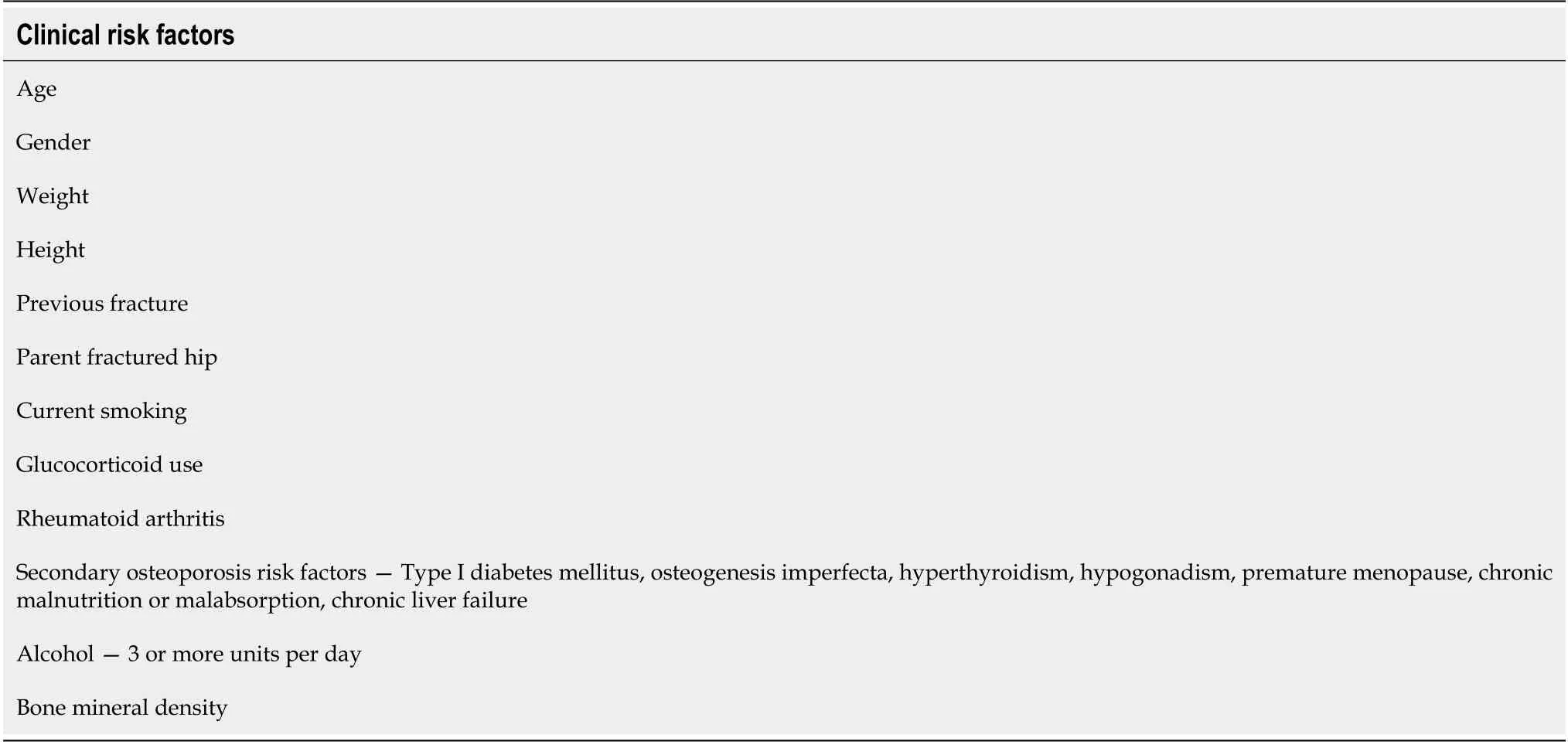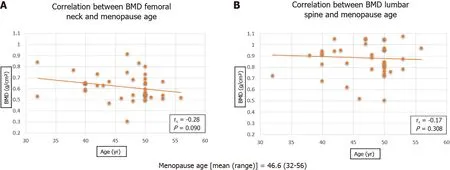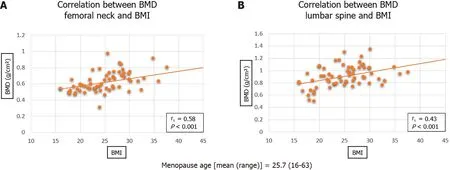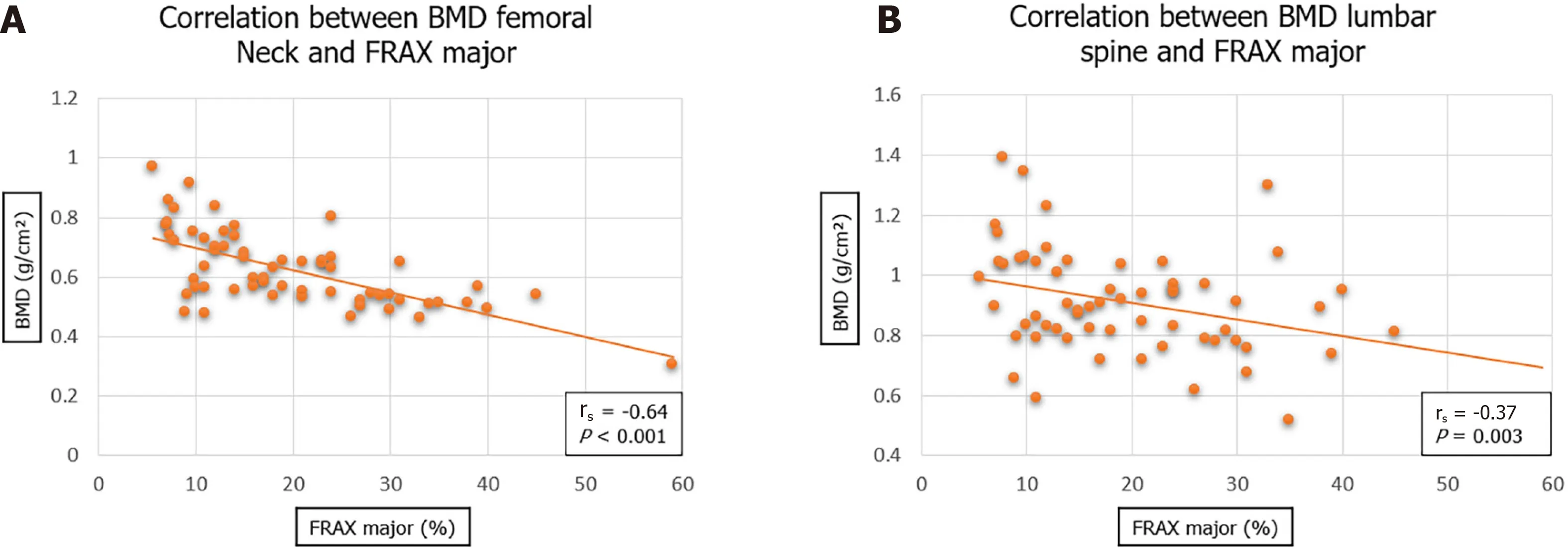Bone mineral density in fracture neck of femur patients:What's the significance?
2022-03-05HussamElaminAhmedOdayAlDadahDepartmentofTraumaandOrthopaedicSurgerySouthTynesideDistrictHospitalHartonLaneSouthTynesideNE340PLUnitedKingdom
lNTRODUCTlON
The National Institute for Health and Care Excellence(NICE)define osteoporosis as a disease characterised by low bone mass and structural deterioration of bone tissue,with a consequent increase in bone fragility and susceptibility to fracture[1].Fractures secondary to osteoporosis may be referred to as fragility fractures;which are described as those resultant from a mechanical force that would not ordinarily be associated with a fracture[2];further described by the World Health Organization(WHO)where a fracture occurs from forces equal to or less than a fall from a standing height[1].
She was delighted with the beautiful deer, and cried to her nurse: Catch it! if you will I will give you this necklace, every pearl of which is worth a kingdom
Osteoporosis may be viewed as primary or secondary.Primary being characterised by age and sex hormone related progressive mineral loss[3].Secondary osteoporosis occurs as a result of different pathologies and use of specific medication[4].
Osteoporosis is a disease that develops silently,only manifesting on occurrence of a fracture.It is for this reason that the increase in osteoporosis related pathology has been entitled by some as the “silent epidemic”[4].The WHO considers osteoporosis to be only second to cardiovascular diseases as a crucial healthcare issue[5].
She promised42 her godmother she would not fail of leaving the ball before midnight; and then away she drives, scarce able to contain herself for joy. The King s son who was told that a great princess,43 whom nobody knew, was come, ran out to receive her; he gave her his hand as she alighted out of the coach, and led her into the ball, among all the company. There was immediately a profound silence,44 they left off dancing, and the violins ceased to play, so attentive31 was everyone to contemplate32 the singular beauties of the unknown new-comer. Nothing was then heard but a confused noise of:
Neck of femur fractures were classified as intra-capsular or extra-capsular.Extra-capsular fractures were defined as those at the inter-trochanteric line(fracture line passes through the greater trochanter to the lesser trochanter)or distal to this as assessed on plain radiograph imaging(antero-posterior pelvis and lateral hip).Fractures proximal to the inter-trochanteric line were classified as intra-capsular fractures.This is a validated radiographic classification system of fracture neck of femur pattern[16].
Despite the above figures,it is almost impossible to truly predict the economic burden of osteoporosis and osteoporotic fractures.The consequences are not only that of economic cost to the healthcare system,but also of associated morbidity,impairment,reduced quality of life and mortality.It is therefore paramount that resources and research into fracture prediction and prevention continues,to ensure that efficient allocation of resources may continue in an already stretched healthcare system.
The International Osteoporosis Foundation and the WHO state that fracture risk should be advised as a short-term absolute risk[8].A period of ten years is agreed upon as this comprises the probable duration of treatment as well as the benefits that may continue once treatment is ceased[4].There are several different predicting tools used to identify risk of fragility fracture.The fracture risk assessment tool(FRAX)is a predictive algorithm developed by the University of Sheffield that takes into account clinical risk factors,with or without the addition of bone mineral density(BMD)[9,10].The FRAX tool provides a 10-year probability of hip or major osteoporotic fracture by means of a percentage likelihood[11].The clinical risk factors utilised as part of the FRAX predictive tool are displayed in Table 1.

BMD is defined as grams per centimetre squared(g/cm)[12].This is measured by means of dualenergy X-ray absorptiometry(DXA)scan.A value of BMD(g/cm)is therefore given for the area of bone scanned(most commonly proximal femur and lumbar spine)[12].Alternatively,the value may be converted to a value in comparison(standard deviation)with the peak bone mass of a Caucasian female aged 30(T-score),or for the peak bone mass adjusted for age,gender and race(-score)[12].It is the Tscore that is used by the WHO as an objective means of defining osteoporosis in an individual as per DXA scan result;with Osteoporosis being defined as T-score less than or equal to-2.5(Table 2)[13].

Currently in the United Kingdom it is common practice for the FRAX tool to be used by a primary care physician to give 10-year probability of major osteoporotic fracture.NICE guidelines currently advise if the value is significant,then preventative management is to be initiated immediately,however if the risk is moderate,a DXA scan is advised to further quantify the probability.
A number of recent publications have focused on re-assessment of the importance of clinical risk factors associated with the progression to osteoporosis,including BMD.Trajanoska[14]conducted a meta-analysis of genome-wide association studies and a two-sample mendelian randomisation approach to assess the role of fifteen clinical risk factors on osteoporotic fracture risk.It was deduced that among clinical risk factors for fracture that were assessed,only BMD was shown to have a major causal effect on fracture.This mendelian randomisation study provides evidence against a causal effect of several proposed clinical risk factors for fractures(,diabetes,glucose,rheumatoid arthritis,and vitamin D)[14].
Findings from the Foundation of the National Institutes of Health(FNIH)Bone Quality Project,a meta-analysis of twenty-two trials,have shown that a twenty-four percent change in BMD,as per DXA measurement,is responsible for a large proportion of the fracture risk reduction across a range of osteoporosis treatment options[15].The regression analysis conducted as part of the study displayed percentage difference in increase in BMD(change in BMD with treatment minus the change in BMD with placebo)at the hip,femoral neck,and lumbar spine was significantly associated with relative risk reduction of having a fracture[15].This,in turn,supports the notion that the BMD,as measured per DXA scan,be utilised as a surrogate biomarker in the measurement of disease progression and management of osteoporosis.
As part of recent guidelines,NICE have recommended research to be focused on the added prognostic value of BMD in the assessment of fracture risk with FRAX[1].NICE state that there is currently not sufficient research,in primary or secondary care,evaluating if the addition of BMD to FRAX improves the accuracy of the predicted fracture risk[1].More specifically,NICE advise further research is required to ensure that the addition of BMD results in the correct re-classification of risk,,high to low risk and vice versa[1].
The authors hypothesise an increased significance of BMD in comparison to the individual components of the FRAX score.The aim of this study was to investigate the significance of BMD in fracture neck of femur patients and compare it to the outcome of the FRAX score.
Hornyansky believes that Rumpelstiltskin is a devil character and thus unsympathetic despite the abuse he receives. There are only two beings in the universe who have secret names, unknown to all but the adept: one of them is God, whose holy Name must not be spoken; the other, over whom mortal man may gain power by pronouncing his mysterious proper name, is the devil (Hornyansky 1965, 130).
MATERlALS AND METHODS
Patients
This retrospective observational cohort study which did not require ethics committee approval.All patients had sustained a fracture neck of femur and managed as appropriate under the admitting oncall consultant orthopaedic surgeon between 2015 to 2017.
All patients underwent a DXA scan following completion of management of the fractured neck of femur.DXA images were taken of the contralateral femoral neck and the lumbar spine(L2,L3,L4),in line with published protocols[5,10,11].Patients with contralateral hip prosthesis in-situ and with lumbar spine instrumentation were excluded from the study.FRAX scores were calculated for all the patients included in the study.
Fracture pattern classification
Prevalence of osteoporosis is known to increase with age,from 2% at age 50 years to 25% at age 80 years[1].There are known to be over three million United Kingdom residents with osteoporosis at present[6],with this figure expected to continue to rise.Subsequently,the burden on healthcare services as a result of osteoporosis is only likely to rise with the ongoing increase in the world population.In the United Kingdom alone;projections suggest that the incidence of fragility fractures is likely to increase by 21% by the year 2020(230000 per annum),with a resultant overall annual cost upwards of £2.1 billion[6].In Europe it is estimated that direct costs resulting from osteoporotic fractures to have an overall cost of €76.7 billion[7].
Proposed outcome
The authors aim to investigate the association between BMD and the components of the FRAX score within the cohort.
Statistical analysis
All continuous data variables displayed a skewed distribution(verified by both plotted histograms and the Shapiro-Wilks test).The appropriate non-parametric statistical test was used in their analyses.This includes Mann Whitneytest and Kruskall-Wallistest used in the appropriate manner.The Chisquared test was used for the categorical data analysis of the fracture neck of femur pattern type and the Spearman Rank test was used for the correlation analyses.The level of statistical significance was set at< 0.05.Statistical analysis was performed using SPSS for Windows version 25.0(IBM Corp.,Armonk,New York,United States).
8. Terribly dark, and raining so heavily and blowing so hard: In other words, it was a dark and stormy night, the now cliched setting for a story.Return to place in story.
RESULTS
Table 3 displays the demographic data of the study cohort.A total of 69 patients were included in the cohort,all undergoing DXA scan following fracture neck of femur and undergoing a complete FRAX score assessment.
Table 4 shows the fracture neck of femur classification pattern.Table 5 shows the details of the surgical management.
The mean FRAX score for a major osteoporotic fracture amongst the study cohort was 19.87%(SD 11.01%);this score representing the percentage probability of occurrence of fracture of the distal radius,proximal humerus,lumbar spine or neck of femur over a ten-year period(Table 6).In addition,the mean FRAX score for fracture neck of femur amongst the study cohort was 7.75%(SD 8.09%);representing the ten-year percentage probability of fracture neck of femur only(Table 6).BMD of the femoral neck and lumbar spine where used to calculate the corresponding T-score and-score.Table 2 shows the WHO classification of Osteoporosis when interpreting T-score values.None of the patients included in this study fitted the classification grade of osteoporosis as all of them had fragility fractures and so by definition were classified as severe osteoporosis when the T-score ≤-2.5.
Limitations of the study included that much of the presented data focuses on the influence of gender on BMD,and consequently the influence of gender on osteoporosis and fracture risk.One must make note of the differences in frequency between males(= 25)and females(= 44).This was appropriately adjusted for in the statistical analyses conducted.This gender discrepancy is explained by the disproportionately higher incidence of fracture neck of femur in females as compared to males[28].




Figure 1 illustrates the scatter plot graph showing no significant correlation between the menopause age of female patients and the BMD of either the femoral neck or lumbar spine.
The doctor said that the impact6 on her brain had caused her to lose her voice. Listening to her parents comfort, but with nothing coming out from her, she broke down.



Figure 2 shows a significant direct correlation between body mass index(BMI)and BMD for both femoral neck(r= 0.58;< 0.001)and lumbar spine(r= 0.43;< 0.001).

Table 10 shows a statistically significant difference(= 0.026)between the pattern of fracture neck of femur and the WHO Classification of femoral neck BMD.Patients with extra-capsular fractures where more likely to have severe osteoporosis than those with intra-capsular fractures.

Figure 3 illustrates a statistically significant inverse correlation between the femoral neck BMD and the lumbar spine BMD with the FRAX major score(percentage likelihood of major osteoporotic fracture in the next ten years).The correlation was stronger with the femoral neck BMD(r=-0.64;< 0.001)than that of the lumbar spine BMD(r=-0.37;< 0.001).
My father, like my mother, was deaf, so I grew up living in two worlds, our private world and the hearing world outside. I was on intimate terms with silence and the language of silence.
What I remember most about those weddings is that all the girls were at least five years older than I was, and they all had beautiful eyes that sparkled when they laughed. Those weddings taught me to imagine what it would be like to find my soul mate one day and to be sure that I would know her by her beautiful eyes.


DlSCUSSlON
Increased prevalence of osteoporosis fragility fractures in the NHS,causing an increased economic burden.
The aetiological factors associated with development of both primary and secondary osteoporosis have been looked at in numerous studies.With the incidence of osteoporosis continuing to rise[17],it is important that new research continues to advance and build upon previous findings.
The clinical risk factors associated with development of osteoporosis have long been agreed upon,with emerging contributory risk factors to secondary osteoporosis being a constant subject of further research[18].However,the significance of the contribution of certain clinical risk factors to the pathophysiology of the development of primary osteoporosis is less understood.This study aimed to investigate the significance of BMD in fracture neck of femur patients and compare it to the outcome of the FRAX score.
This study addressed a relatively unique cohort,all patients had sustained a major osteoporotic fracture(,fracture neck of femur).This allowed for research into arguably the most at risk group of individuals in the community.This contrasts to previous literature,whereby major osteoporotic fracture is used as an end-point on patient follow-up[10].
Local clinical guidelines allow for the discretion of the referring clinician with regards to whether DXA scan is appropriate following surgical management and rehabilitation of fracture neck of femur patients.In general,this would be all patients under the age of 75,as well as those patients felt to be independent in all aspects of daily living.This ensures that those included in this cohort will potentially benefit from preventative medical treatments to avert further major osteoporotic fractures.In addition,this ensures that 10-year percentage probability of major osteoporotic fracture data generated is relevant for the cohort.
The majority of patients with intra-capsular fracture neck of femur were managed with total hip arthroplasty,as opposed to hemi-arthroplasty,as displayed in Table 5.This reflects the relatively low mean age of the patients in the cohort.Current National Institute for Health and Care Excellence(NICE)guidelines advise that fracture neck of femur patients be managed surgically by total hip replacement if they are independently mobile and independent in activities of daily living[18].This,in turn,portrays that the cohort in this study represents a group of individuals who are expected to continue with an independent lifestyle after surgical management,and therefore it is important that further fracture prevention is prioritised by all members of the healthcare team.Osteoporosis was more common in patients with extra-capsular hip fracture patterns in this study.Dynamic hip screw(DHS)is a common internal fixation device used for this fracture pattern.The biomechanical pull-out strength of locking plates is superior to that of conventional plates particularly in osteoporotic bone.It may be more prudent to use DHS implants which have locking plates for screw fixation in the surgical management of patients with an extra-capsular fracture configuration.
The significant(inverse)relationship between femoral neck BMD and lumbar spine BMD with the FRAX score(10-year percentage probability of major osteoporotic fracture)is in agreement with previous literature[17,20].This supports the ongoing understanding that measures to increase BMD will result in reduced incidence in major osteoporotic fractures[15,21].
The correlation between BMD(both femoral neck and lumbar spine)and BMI is also in agreement with previous literature[22].This is likely to be explained by a combination of factors,including nutritional status,mechanical load and hormones.It has previously been hypothesised that increased weight,and subsequently increased mechanical load,results in decreased osteoclast activity and increased osteoblast activity,increasing bone strength and bone mineral content[23].This supports current emphasis on nutritional status of fracture neck of femur patients,not only in aiding rehabilitation,but also in prevention of further fracture.
BMD was noted to have a significant influence on the fracture pattern at the neck of femur.This is also in agreement with previous literature[16],whereby extra-capsular fracture patterns are associated with a lower BMD.However,it is important to emphasis that literature has shown there to be other factors that will have an influence on fracture pattern at the neck of femur[24],most notably intertrochanteric outer diameter and buckling ratio.
Gender difference has long been known to have an influence on both osteoporosis fracture risk and BMD.This is variable is included in the FRAX questionnaire[25].Interestingly,there was no significant difference between males and females for BMD within the cohort studied.It is important to note that it is not the intention to disprove the influence of gender on BMD,and ultimately osteoporosis.However,it may be argued that the effect of gender is not in isolation,and that other factors that affect BMD(nutrition,mechanical force,genetic predisposition,ethnicity,)may outweigh gender’s overall role.
It was shown that menopause age did not have a significant association with either BMD or WHO osteoporosis classification.This is in contrast to the majority of published literature[26],whereby it is understood that earlier menopause age is associated with lower BMD,and therefore increased incidence of osteoporosis and fragility fractures[27].This study does not conclude that age of menopause has no effect on BMD,osteoporosis and fracture risk.However,it emphasises that a multi-faceted approach must be taken when attempting to address the field in question.
Table 7 shows that there was no statistically significant difference for either BMD of femoral neck or lumbar spine between males and females.
Recommendations for future research include a greater focus on how BMD may help reclassify patient fracture risk when added to the already calculated FRAX score based on 10-year probability of both major osteoporotic fracture and fracture neck of femur.This will aid to ensure osteoporosis preventative management is appropriately prioritised to reduce the incidence of fragility fractures.The findings in this paper also support the requirement for further research into the use of BMD as a surrogate biomarker for both fracture risk and osteoporosis prevention and management.This may be in the context of a cross-sectional study of fragility fractures at differing ages group and further appropriate stratification as per age,with confounding factors adjusted for.
CONCLUSlON
After pulling the car into the garage, I went inside and headed for the hall closet. By this time, Holly was sitting at the kitchen table staring out the window.
5. A beautiful sweet cake: The Jack18 Zipes edition of the tale gives pancake instead (Complete 256).While wine does have symbolic19 associations (particularly as the blood of Christ or other sacrifices [Biedermann 383]), it seems used to show preference here. The cake and the wine show how much the mother values her eldest sons.Return to place in story.
ARTlCLE HlGHLlGHTS
Research background
There has been a steady increase in fragility fractures in the United Kingdom and worldwide.This has been seen in the increased number of patients admitted with fracture neck of femur.It is essential to gain a further understanding of the aetiology to understand preventative measures.
Research motivation
The main findings of this study were that BMD had a significant correlation with the FRAX score and also with BMI.Neither female gender or early menopause age had a significant influence on BMD.Osteoporosis was more common in patients with extra-capsular hip fracture patterns.
Research objectives
The aim of this study was to investigate the significance of bone mineral density(BMD)in fracture neck of femur patients and compare it to the outcome of the Fracture Risk Assessment Tool(FRAX)score.
The results in this study place more emphasis on BMD when assessing fracture risk,in comparison to key factors incorporated into the FRAX predictive score.Menopause age and female gender had an indeterminate influence on BMD,as well as WHO classification of osteoporosis.BMI had a significant influence on BMD.Osteoporosis was more common in patients with extra-capsular hip fracture patterns.This study shows that BMD is significant in assessing risk of fracture neck of femur in comparison to the FRAX predictive score.
Research methods
Statistical analyses undertaken to ascertain the relationship between BMD and the individual factors included in the FRAX score.
Research results
The results in this study place more emphasis on BMD when assessing fracture risk,in comparison to key factors incorporated into the FRAX predictive score.Menopause age and female gender had an indeterminate influence on BMD,as well as World Health Organization classification of osteoporosis.BMI had a significant influence on BMD.Osteoporosis was more common in patients with extracapsular hip fracture patterns.This study shows that BMD is significant in assessing risk of fracture neck of femur in comparison to the FRAX predictive score.
Research conclusions
This study demonstrated that BMD of the femoral neck measured by dual-energy X-ray absorptiometry scan is of added prognostic value when assessing patients for risk of fracture neck of femur in combination with the FRAX predictive scoring system.
Tables 8 and 9 show no statistically significant difference between the mean menopause age of female patients and the WHO classification of the femoral neck BMD and the lumbar spine BMD respectively.
Research perspectives
The findings in this paper also support the requirement for further research into the use of BMD as a surrogate biomarker for both fracture risk and osteoporosis prevention and management.This may be in the context of a cross-sectional study of fragility fractures at differing ages group and further appropriate stratification as per age,with confounding factors adjusted for.
FOOTNOTES
Elamin Ahmed H contributed to study design,literature review and manuscript production;Al-Dadah O contributed to study design,literature review,statistical analysis and manuscript production.
At 90, cellist Pablo Casals would start his day by playing Bach. As the music flowed through his fingers, his stooped shoulders would straighten and joy would reappear in his eyes. Music, for Casals, was an elixir that made life a never ending adventure. As author and poet Samuel Ullman once wrote, Years wrinkle the skin, but to give up enthusiasm wrinkles the soul.
This was a retrospective observational cohort study which did not require IRB/Ethics Committee approval.
King Cloverleaf and Queen Frivola had but one child, and this Princess had from her very babyhood been so beautiful, that by the time she was four years old the Queen was desperately2 jealous of her, and so fearful that when she was grown up she would be more admired than herself, that she resolved to keep her hidden away out of sight
Informed consent was obtained from all patients as part of their routine clinical care in this pragmatic study which evaluated the existing clinical practice within the department.
The authors report no conflict of interest.
No additional data are available.
Even though the daylight hours are growing longer minute by minute, it’s easy to find an excuse not to go out unless you absolutely must, but bhen again I often have to push myself to accomplish things
The authors have read the STROBE Statement-checklist of items,and the manuscript was prepared and revised according to the STROBE Statement-checklist of items.
This article is an open-access article that was selected by an in-house editor and fully peer-reviewed by external reviewers.It is distributed in accordance with the Creative Commons Attribution Noncommercial(CC BYNC 4.0)license,which permits others to distribute,remix,adapt,build upon this work non-commercially,and license their derivative works on different terms,provided the original work is properly cited and the use is noncommercial.See:https://creativecommons.org/Licenses/by-nc/4.0/
United Kingdom
Hussam Elamin Ahmed 0000-0003-4174-9993;Oday Al-Dadah 0000-0002-1940-836X.
Gao CC
A
Yu HG
杂志排行
World Journal of Orthopedics的其它文章
- Assessing the academic achievement of United States orthopaedic departments
- COVlD-19 pandemic:An update on the reaction attitude of the spine societies and their members worldwide
- Clinical efficacy of the Ankle Spacer for the treatment of multiple secondary osteochondral lesions of the talus
- Liverpool carpal tunnel scoring system to predict nerve conduction study results:A prospective correlation study
- Periprosthetic joint infections in femoral neck fracture patients treated with hemiarthroplasty-should we use antibiotic-loaded bone cement?
- Femoroacetabular offset restoration in total hip arthroplasty;Digital templating a short stem vs a conventional stem
